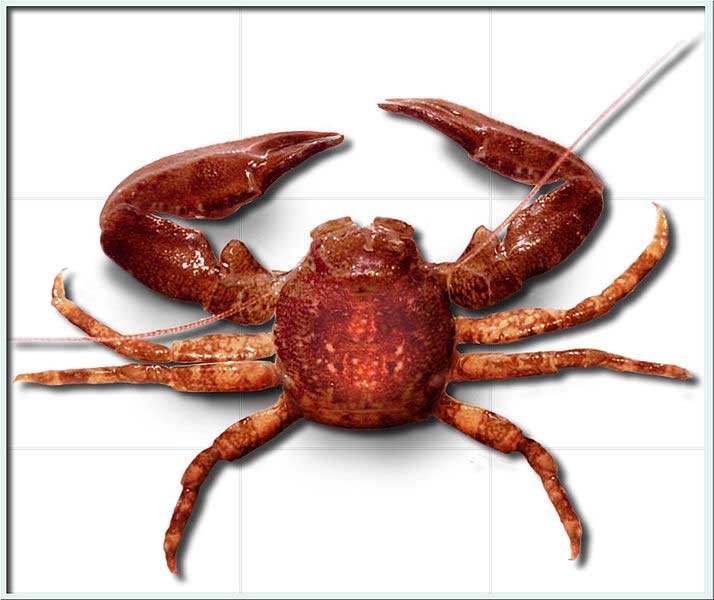
Pisidia longicornis (*)
Superregnum: Eukaryota
Cladus: Unikonta
Cladus: Opisthokonta
Cladus: Holozoa
Regnum: Animalia
Subregnum: Eumetazoa
Cladus: Bilateria
Cladus: Nephrozoa
Cladus: Protostomia
Cladus: Ecdysozoa
Cladus: Panarthropoda
Phylum: Arthropoda
Cladus: Pancrustacea
Superclassis: Multicrustacea
Classis: Malacostraca
Subclassis: Eumalacostraca
Superordo: Eucarida
Ordo: Decapoda
Subordo: Pleocyemata
Infraordo: Anomura
Superfamilia: Galatheoidea
Familia: Porcellanidae
Genus: Pisidia
Pisidia longicornis, the long-clawed porcelain crab, is a species of porcelain crab that lives in the north-eastern Atlantic Ocean. It varies from reddish to white, and grows to a carapace width of 1 cm (0.4 in). It was first named by Carl Linnaeus in 1767, although the etymology remains unclear.
Description
Adult Pisidia longicornis typically have a carapace length of 1 centimetre (0.4 in).[2] Its colouration is variable, with most individuals being reddish or orange, but some having patches of pearly white, or even being entirely white.[3] One cheliped (claw-bearing appendage) is usually larger than the other, although this difference is less pronounced in females than in males.[4] The fifth pair of legs is reduced in size and may be difficult to see.[3]
Distribution and ecology
Pisidia longicornis is found in the north-eastern Atlantic Ocean from Norway to Angola, and throughout the Mediterranean Sea.[2] It is found from the lower shore down to depths of 70 metres (230 ft) in the north Atlantic, but at depths of 30–100 m (100–330 ft) in some locations around the Mediterranean Sea.[2] It lives under boulders and among bryozoan turfs,[3] and may occasionally be found in fish markets among mussels and oysters.[2]
It feeds by filtering suspended material from the sea water. Individuals from the intertidal zone tend to be larger than those from deeper water, which may be related to the greater churning of the sediment by the tide.[5]
Life cycle
Females bear eggs from March to August around the British Isles, and from February to September in the Mediterranean Sea.[2] Young Pisidia longicornis go through two zoeal (larval) stages before reaching the megalopa (post-larval) stage.[6] The zoea larvae bear "exceptionally long" spines on the carapace, one directed forwards, and two directed backwards.[6] The second zoeal stage may reach a length of 10 millimetres (0.4 in), while the megalopa has a carapace width of 1.5 mm (0.06 in).[6]
Taxonomy
Pisidia longicornis was first described in 1767 by Carl Linnaeus, originally under the name Porcellana longicornis, in the 12th edition of his Systema Naturae. The specific epithet longicornis is difficult to explain, it being Latin for "long-horned", from longus and cornu; it may refer to the long chelipeds (claw-bearing appendages).[2] The species was moved from the genus Porcellana by William Elford Leach when he established the genus Pisidia in 1820.[2]
External links
Pisidia longicornis British Marine Life Study Society
References
Michael Türkay (2009). "Pisidia longicornis (Linnaeus, 1767)". World Register of Marine Species. Retrieved August 24, 2010.
Ray W. Ingle (1997). "Pisidia longicornis". Crayfishes, lobsters, and crabs of Europe: an illustrated guide to common and traded species. Cambridge University Press. pp. 112–113. ISBN 978-0-412-71060-5.
Keith Hiscock (2008). "Pisidia longicornis. Long clawed porcelain crab". Marine Life Information Network: Biology and Sensitivity Key Information Sub-programme. Marine Biological Association of the United Kingdom. Archived from the original on June 13, 2011. Retrieved August 24, 2010.
G. Smalley (1973). "Some notes on the sexually dimorphic characters of Pisidia longicornis (L.) (Decapoda Anomura)". Crustaceana. 25 (2): 220–222. doi:10.1163/156854073X00858. JSTOR 20102034.
G. Smaldon (1972). "Population structure and breeding biology of Pisidia longicornis and Porcellana platycheles". Marine Biology. 17: 171–179. doi:10.1007/BF00347308.
C. D. Todd, M. S. Laverack & Geoffrey Allan Boxshall (1996). "Figure 31: A–D Phylum Arthropoda, Class Crustacea, Subclass Malacostraca – Order Decapoda (Section Anomura)". Coastal marine zooplankton: a practical manual for students (2nd ed.). Cambridge University Press. ISBN 978-0-521-55533-3.
Retrieved from "http://en.wikipedia.org/"
All text is available under the terms of the GNU Free Documentation License

